Hugelkultur is a method of making a garden bed using waste wood and available nitrogen, that preserves those nutrients and gives them up to growing plants over several seasons. Like compost, a hugelkultur bed or hugel bed makes use of carbon and nitrogen to decompose and create humus, while generating both heat and moisture.
Hugelkultur beds:
- Heat up faster in the spring
- Retain moisture
- Need no additional fertilizer
- Need less irrigation
- Produce more food in less space
- Are an efficient use of resources
- Are easier to weed
- Are great for perennial crops
- Are rich in nitrogen
- May need supplemental minerals or kelp fertilizer to balance
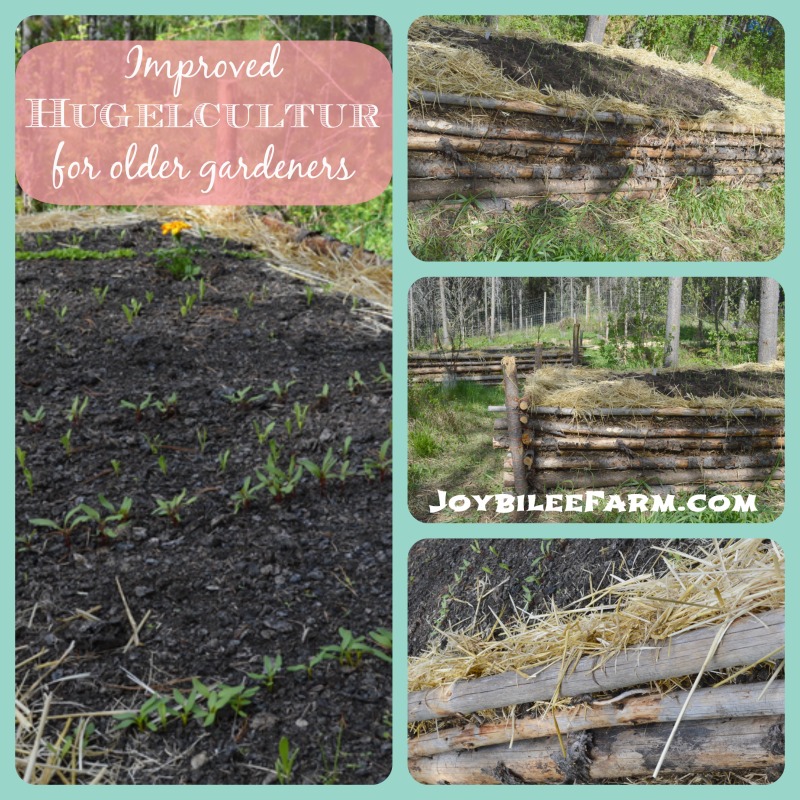
Two years ago we built a hugelkultur bed in our forest garden using waste wood, straw, animal manure, and finished compost. The bed had some difficulties.
Year one:
I planted carrots and beets in the hugel bed the first year. The root vegetables air-pruned when the long roots went through the compost on the top of the bed and hit the area below where the waste wood was. That meant, that while the carrots did grow, we didn’t get much of a harvest. But it was a good learning experience.
Year two:
My chickens got through the fence in the second year and scratched out quite a bit of the surface compost from the top of the bed. We replenished the finished compost and built the bed back up the second spring, and planted strawberries. The bed was easy to weed. The strawberries did well. Near the end of the season the strawberry leaves turned pale with pronounced green veins – chlorosis. This is corrected with the addition of a magnesium solution, which increases the bioavailability of some trace minerals in the soil.
Year 3:
The hugel bed shrunk in height in the third year, as more of the waste wood rotted beneath. The bed was quicker to heat up in the spring and retained its moisture, not needing to be watered when the rest of the garden was. The leaves are again showing signs of chlorosis and will need to be treated with magnesium sulphate to increase the bioavailablity of trace minerals.
What I wanted changed:
Over all, I wanted the hugel bed to be higher so that, as I get older, I can garden with less bending and squatting. The hugel bed can be made as high as the available waste wood. Our farm helper built two new hugel beds this year and built up the walls with logs so that the beds are high enough that I can garden standing up. I love it. They were so easy to plant and will be easy to weed as well. The beds were finished two weeks ago and after the first rain, they started to warm up significantly. Both are already planted. Seed germination was quick and thorough.
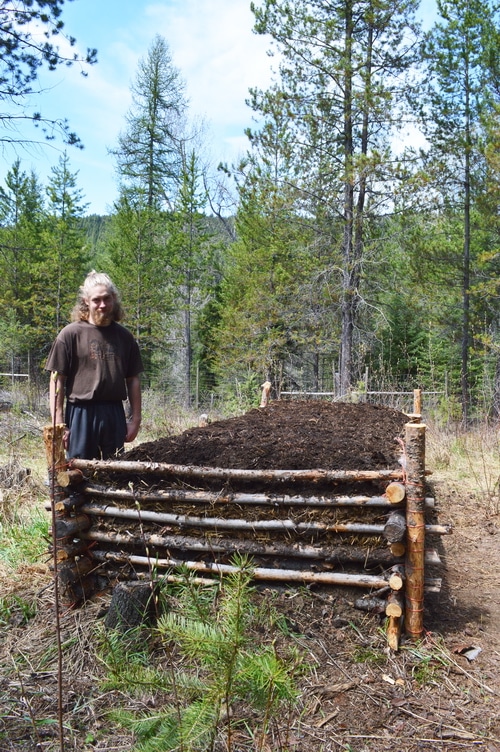
Nathan, our farm helper, built the sides up with waste wood, and threw the stumps and branches in the middle of the bed, to provide the foundation.
Since we raise llamas there were several llama dung piles around the barn yard, and Nathan cleaned those up and dumped the dung over the logs to fill up the spaces. Two jobs with one action – economy of time. This was topped with about a foot of 1 year old composted manure – still clumpy with lots of hay and straw in it. The final layer was a foot of finished compost ready to plant. I pushed straw around the perimeter of the top of the bed to catch any irrigation run off and keep it in the bed. Once the seeds are 6 inches high, and it warms up here, I’ll mulch the bed with straw to prevent the surface from drying out.
What I like about the new design:
- It’s taller
- It is neater in appearance
- The sides won’t cave in as the bed decomposes
- I can garden standing up
- It’s deeper and therefore has more mass to retain heat and moisture
- It’s less fatiguing to plant standing up than to plant bending over
- The plants in the hugel bed are growing more quickly than the plants I put in the ground at the same time.
- Soil moisture can be made more efficient by digging a trench around the bed to catch run-off and direct it back to the bed.
- The raised bed is easier to cover with row covers to extend the season.
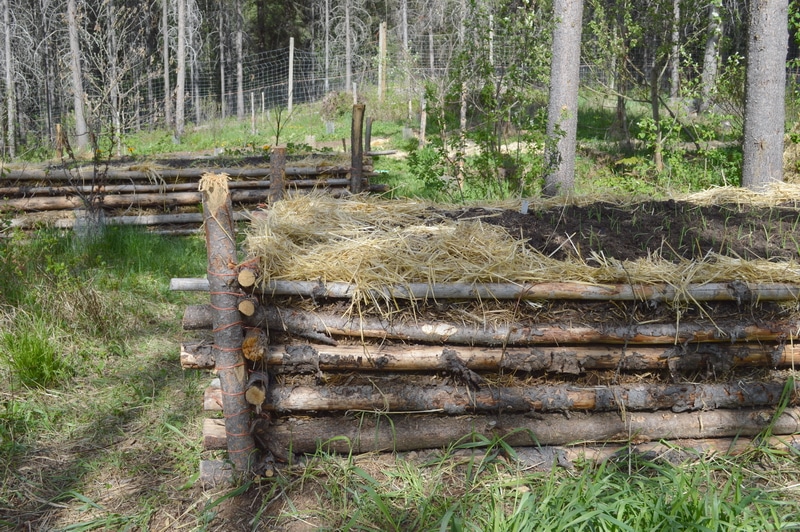
Some drawbacks:
I noticed that some of the waste wood had ants and I will have to discourage them from using the hugel bed as a home
There are places for mice, voles, and wasps to house within the walls of the hugel bed, so I’ll need to watch for this, and take steps to discourage it.
The bed will sink as the waste wood decomposes and more compost will have to be added periodically. This is not really a draw back as I have lots of manure and composted manure on the farm and this makes good use of it.
I’ll avoid growing plants with long tap roots, like carrots, beets, and kale until the bed has been established for several seasons.
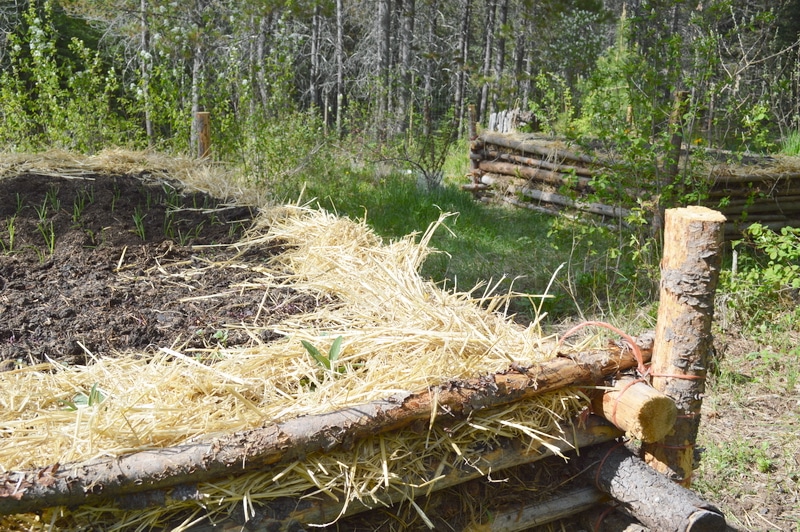

The hugel bed is a permaculture technique to increase the efficiency of biowaste products and grow more food. I think it’s a really good technology. There are as many forms of hugelkultur as there are gardeners. I suggest that you take the good points that work for you, and as I did, fine tune them to your own situation and the available biomass that you have to work with.
As the bed decomposes and shrinks, you’ll want to add more compost to the surface to keep it high. Larger hugelbeds made with the help of a tractor and utilizing whole trees, won’t need as much attention as smaller, human size beds.
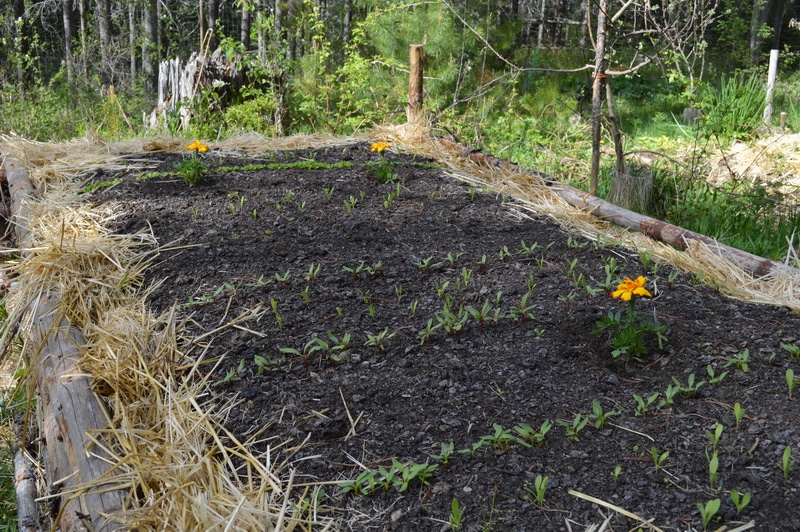
If you have a source of manure and waste wood, give hugelkultur beds a trial run on your homestead. But don’t settle for the low beds. Instead build up the bio-mass and extend the height and make a hugelkultur bed that will be kind to you in your senior years.



I’ve seen reports on this from other homesteaders. Definitely something to be aware of.
a big issue I ran into when getting manure from a ranch/rodeo horse breeder I knew – the hay they brought in for the horses/cows was treated with a ‘broad spectrum’ broadleaf weed killer that would prevent anything but grasses from setting fruiting bodies. and it passed through the horse and cow digestive tract and excreted into the compost. (Clopyralid and aminopyralid type herbicides)
that stuff will stay in your garden beds for /years/. I got several buckets of manure, took it home, added it to my beds, and it was as good as salting the ground. killed or stunted everything except my corn. and it does ‘not’ break down in composting. the only way to be rid of it is to basically wind up thinning it out into the parts per million range.
https://extension.umd.edu/learn/gardener-alert-beware-herbicide-contaminated-compost-and-manure (for reference)
I’ve read that too. It’s best to know the farm where you are getting the manure from. Same with any hay or straw that you put down for mulch. Always ask the farmer if they use herbicides on their farm before bringing it to your garden. I’d do the same with leaves. Many trees absorb heavy metals and are used to clean up toxic waste sites. If you use leaves from those trees on your garden, you could be introducing heavy metals to your vegetable soils.
I have read several comments at other sites about using manure that say they encountered manure laced with herbicides that killed their crops. How do I avoid this? it was something in the feed for the horses or cows. Also, what manure is preferred? I live on 5 acres of wooded bluff, not enough level land to raise any large animals so do not have my own source of manure.